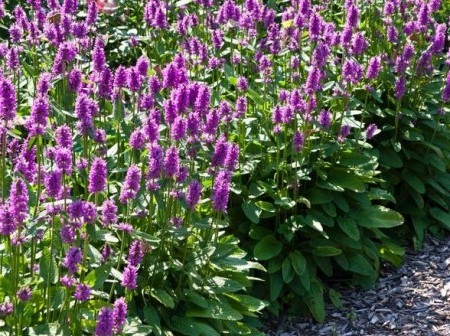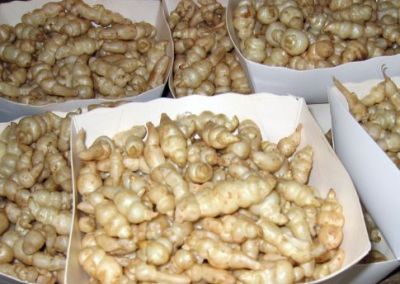Summer residents are more familiar with Stachys woolly, a perennial herbaceous rhizomatous plant that gardeners love to grow because of its decorative, densely pubescent silver-gray leaves.
Stachys vegetable is grown much less frequently. Apparently, five-gram (and even less!) nodules do not inspire housewives: there is a lot of fuss. But stachys vegetable is a very useful plant and deserves more attention.You can guess about its healing properties by learning that it belongs to the Lamiaceae. Such representatives of this noble family as basil, mint, catnip, sage, marjoram, oregano, and thyme have long been present in our gardens.
Useful properties of stachys
This plant even looks like mint. And not only the nodules, but also the leaves are used for food: if you add them (but only a little) to the salad, its taste will take on a peculiar shade. But the main nutritional value is its nodules, similar to mother-of-pearl shells. They are boiled, fried, dried, added to soups, vegetable stews, sauces, salted, pickled.
The dried nodules are ground and added to flour. In a word, stachys is universal. Boiled resembles asparagus and cauliflower. But the fact that the nodules are small is not a big problem, since there is no need to clean them before use: they are simply washed thoroughly under running water.
Stachys tubers contain proteins, carbohydrates, vitamin C, calcium, magnesium, iron, selenium, etc. Mature nodules contain almost no starch. Stachys lowers sugar levels, cholesterol, calms, helps in the treatment of flu, high blood pressure, has a positive effect on the body's carbohydrate and fat metabolism, etc.
Winter storage
True, it is difficult to preserve the nodules until spring, even when buried in sand (the optimal temperature is from zero to +3 degrees). But lovers of this culture found a way out. In the fall, not all of the harvest is dug up: some of the plants are left in the garden. Having dug up in the spring, large tubers are immediately planted, and the rest are sent to the kitchen.
To prevent the yield from decreasing, it is advisable to change the location every year.
Planting and caring for stachys
Landing. Before planting, the area is dug up deeply, adding organic and mineral fertilizers (up to a bucket of compost or humus, a tablespoon of superphosphate, potassium sulfate). Sand is added to heavy soils. The best predecessors are cucumbers, tomatoes, and onions.
Planting grooves are made 70 cm apart from each other, tubers are laid out in them after 20 cm and buried to a depth of 5-8 cm. In winter, the planting site is mulched with a five-centimeter layer of compost or humus and covered with leaves.
Care. In the spring, the stachys that begins to grow are weeded and loosened. At the end of August, having pestered the stakhis, they no longer work with a hoe (the grass is pulled out by hand) so as not to damage the stolons, on which nodules begin to form at the end of summer. Water without allowing the soil to dry out.
Harvest. There is no rush to dig up in the fall: frosts will not damage the nodules of stachys, and early harvesting reduces the yield by half.
Stachys is prolific: from a square meter you can get up to one and a half kilograms of tubers.
Stachys forms nodules on stalons (like potatoes). Left in the ground, they germinate in the spring. But this does not pose a great danger to subsequent crops: it is enough to remove the sprouts that appear so that the stachys no longer grows in this area. Therefore, those who compare stachys with horseradish (in terms of aggressiveness) greatly exaggerate.



 CUCUMBERS NEVER GET SICK, I'VE BEEN USING ONLY THIS FOR 40 YEARS! I SHARE A SECRET WITH YOU, CUCUMBERS ARE LIKE THE PICTURE!
CUCUMBERS NEVER GET SICK, I'VE BEEN USING ONLY THIS FOR 40 YEARS! I SHARE A SECRET WITH YOU, CUCUMBERS ARE LIKE THE PICTURE! You can dig a bucket of potatoes from each bush. Do you think these are fairy tales? Watch the video
You can dig a bucket of potatoes from each bush. Do you think these are fairy tales? Watch the video
 How our fellow gardeners work in Korea. There is a lot to learn and just fun to watch.
How our fellow gardeners work in Korea. There is a lot to learn and just fun to watch. Eye trainer. The author claims that with daily viewing, vision is restored. They don't charge money for views.
Eye trainer. The author claims that with daily viewing, vision is restored. They don't charge money for views. A 3-ingredient cake recipe in 30 minutes is better than Napoleon. Simple and very tasty.
A 3-ingredient cake recipe in 30 minutes is better than Napoleon. Simple and very tasty. Therapeutic exercises for cervical osteochondrosis. A complete set of exercises.
Therapeutic exercises for cervical osteochondrosis. A complete set of exercises. Which indoor plants match your zodiac sign?
Which indoor plants match your zodiac sign? What about them? Excursion to German dachas.
What about them? Excursion to German dachas.